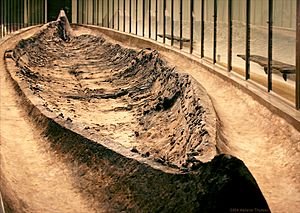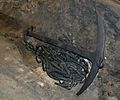Ladby ship facts for kids
The Ladby ship is a famous ship burial found near Kerteminde in Denmark. It's like other important Viking ship burials found in Norway, such as Oseberg and Gokstad. All these ships date back to the 800s and 900s. The Ladby ship is special because it's the only Viking Age ship burial found in Denmark itself. Today, the ship is kept at the place where it was discovered, which is now part of a museum.
Contents
Discovering the Ladby Ship
The Ladby ship was found in a Viking Age burial site. When archaeologists dug there, they found many items and even animal remains buried with the ship. Experts believe the ship was buried in the early 900s. This date comes from a fancy bronze piece for a dog harness, decorated in the Jelling style.
The grave had been badly damaged. Only a few small human bones were found. Some researchers think the body was moved later, perhaps to change it from a pagan grave to a Christian one. Another idea is that the grave was attacked and damaged. This might have happened during a power struggle between King Harald Bluetooth and his son, Sweyn Forkbeard. The ship was a symbol of power. Damaging it would have been a big insult to the family of the person buried there.
The ship was discovered around February 28, 1935. A pharmacist and amateur archaeologist named Poul Helweg Mikkelsen found it. His notes and drawings, along with those from Gustav Rosenberg, are our main sources of information. Mikkelsen paid for a special building to be put over the site. This building was then covered with earth and grass. The site became part of the National Museum until 1994. Now, the Viking Museum at Ladby takes care of it.
Ship burial sites are often found on high ground, like hilltops or slopes. They are also usually close to water, such as a lake or the sea. The Ladby ship fits this pattern. It was found on top of a mound, near Kerteminde Fjord. The ship was likely pulled from the fjord up to the mound using rollers, similar to how the Oseberg Ship was moved. The Ladby ship was a longship, big enough for 30 to 32 rowers.
Digging Up the Ship
The ship was dug up between 1935 and 1937. Because the ship was so old, almost all the wood had rotted away. However, the shape of the ship could still be seen from the nearly 2,000 metal rivets that held the wood planks together.
During the dig, Rosenberg measured the ship. He figured it was about 21.5 meters (70 feet) long. Its widest part was about 2.75 meters (9 feet) across. He made these guesses based on where the rivets were found. Another expert, Knud Thorvildsen, agreed with these measurements later.
Mikkelsen and Rosenberg both wrote detailed notes during the excavation. Rosenberg's notes are very important for understanding the ship and its contents. Mikkelsen's notes were more about his feelings and the excitement of the discovery. At first, Rosenberg thought some iron pieces found were not part of the ship's front (stem). Mikkelsen believed they were. Later, Rosenberg changed his mind. These iron pieces were spiraled bands that decorated the wooden stem, which had rotted away.
The experts believed the spiraled stem looked like the mane of an animal, probably a dragon. The dragon's head itself had rotted away. Viking ships often had removable dragon heads on their stems. It's thought that only kings or very important people were allowed to have dragon heads on their ships. A dragon-ship might have been used in battles by kings like Harald Bluetooth.
As they dug deeper, they found iron nails that showed where the top edge of the ship's side (gunwale) had been. They also found some remains of wood or bark. Most of the ship's wood had disappeared. But they did find some wood where it had touched iron. This helped them understand how the ship was built. They also found a horizontal layer of reddish wood. This was likely part of a deck that had collapsed.
Items Found in the Grave
Many items were found in the burial site. These included weapons, riding gear, tools, and even board games. One special find was the ship's anchor. It was very well preserved. Mikkelsen was very excited when he found the anchor with its chain and rope.
The Ladby anchor is a "stocked anchor." This means it has a heavy wooden bar placed across its arms. This design helps the anchor grip the seabed better. The anchor's chain made it heavier and helped absorb the pull from the ship in waves. The anchor was found on the left side of the ship, near the front. It was in good condition, but the chain was in bad shape.
An expert named Carl V. Solver measured the anchor and chain in 1940. He thought the chain had about 60 links and was 10-12 meters long. Later, he changed his estimate to about 50 links and 10 meters. When the chain was cleaned in 1994, it was found to have at least 78 links of different shapes and sizes. The total length of the chain is probably about 11 meters (36 feet).
Near the anchor, remains of rope were found. It was made from lime-bast, a strong plant fiber. This rope was not strong enough to be the main anchor rope. It might have been used to pull the anchor up or simply stored in the front of the ship. Another thinner rope was also found. Sand in the rope showed it had been in the water.
Horses in the Ship
Mikkelsen and Rosenberg found the skeletons of eleven horses in the front of the ship. Some experts have wondered if Viking war ships, like the Ladby ship, were used to carry horses. Pictures from the Bayeux Tapestry, an old cloth from the 1000s, show Vikings transporting horses.
Some scholars doubted that horses could be carried on these ships. To test this, Danish sea scouts built a copy of the Ladby ship. They found that the ship was wide and flat, making it easy for both rowers and horses to get on board. They could even sail the ship with horses in calm, shallow waters near the coast. However, they realized that in the open, rough sea, the horses would likely have been thrown overboard. This is because the ship's sides were very low, only reaching the horses' knees.
Viking Museum Ladby
Today, the Viking Museum at Ladby shows many of the original items found with the ship. It also gives a great look into the Viking Age in eastern Funen. A new building from 2007 has a full-size copy of the ship burial. It shows how the grave might have looked right after the funeral. You can see the chieftain lying on a bed in the ship, with all his grave goods, his dogs, and his eleven horses.
The museum also has a film about Viking beliefs. It explains their ideas about the journey to the land of the dead, based on Norse mythology and old Picture stones from Gotland.
Literature
- Sørensen, Anne C.: Ladby. A Danish Ship-Grave from the Viking Age, Ships and Boats of The North, Vol. 3; Viking Ship Museum in collaboration with the National Museum of Denmark and Kertemindeegnens Museer, Roskilde 2001, ISBN: 978-87-85180-44-5
Images for kids








